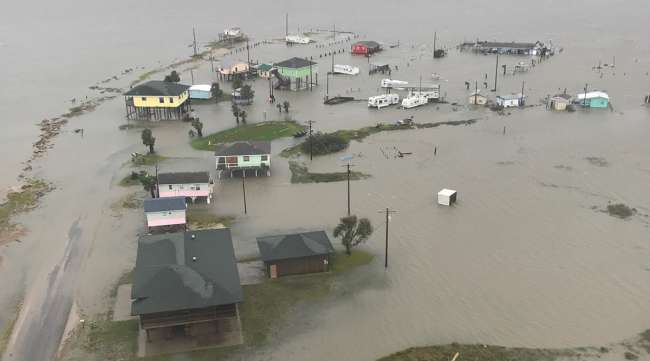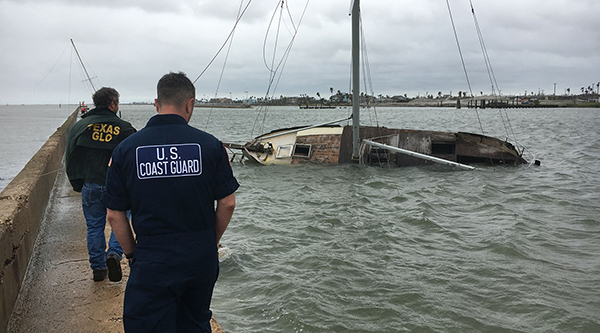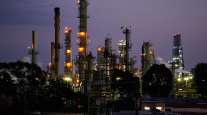Dallas Fed: Harvey’s Economic Damage Temporary; Recovery Boosts Demand

It appears Hurricane Harvey will inflict little long-term disruption on the Texas regional economy, which continued to expand at a “moderate pace” over the past six weeks despite the giant storm, according to a report Oct. 18 from the Federal Reserve Bank of Dallas.
In its chapter of the Beige Book, an anecdotal survey of the economy compiled every six weeks by the Federal Reserve banks, the Dallas Fed said most of the hurricane-related problems in its district were temporary — and that recovery efforts already have spurred demand spikes in several industries.
Hurricanes Harvey and Irma disrupted supply chains, energy prices, transportation and agricultural producers throughout the country, according to notes from the various Fed branches. But outside of the Dallas, Atlanta and Richmond districts, the effects appeared more sporadic.
RELATED: Spot market activity still bustling one month after devastation of Harvey, Irma
Contacts in the Dallas district noted a surge in demand for auto sales, building supplies and other recovery resources in the weeks after Harvey.
The Dallas Fed’s district includes all of Texas and parts of New Mexico and Northern Louisiana. Texas accounts for more than 95% of the region’s economic activity.
The retail sector appeared to encapsulate the storm’s effect — a brief halt in demand, then a ramping up of sales into and outright burst for certain items. Surveyed three weeks after the storm, the district’s retailers as a whole said demand accelerated since the last report.

Coast Guard and partner agencies assess the Port of Corpus Christi near Port Aransas, Texas, Aug 30, 2017. The damage occurred after Hurricane Harvey made landfall in Corpus Christi. Photo by U.S. Coast Guard.
Along the Gulf Coast specifically, two-thirds of retailers said they were impacted by the storm, shutting down an average of four days and seeing reduced sales for about 10 days, the report said. Services firms that reported disruptions said they lasted one to two weeks on average.
But in the weeks since the storm, as one might expect, recovery efforts have boosted sales at building supplies stores and other retailers. Auto sales surged in Houston, according to the report, with one dealer noting “incredibly strong sales” and estimating that hundreds of thousands of cars were flooded.
RELATED: US payrolls fall for the first time since 2010 on storms
The resilience and continued expansion of regional economy helped sustain hiring and wage increases over the past six weeks, the report said. Contacts across a wide range of industries noted labor shortages, impeding the growth of factories and driving up overtime costs for service-providing firms.
More than a quarter of companies surveyed by the Dallas Fed said they expect more difficulty finding workers because of the hurricane, and construction firms said they were bracing for shortages as workers flock to rebuilding jobs in Houston and along the Gulf Coast.
In Houston, single-family homes suffered the most damage, the report said.
Despite some shutdowns along the Coast and trouble finding qualified workers, the “robust” expansion of regional factory production continued, led by computer and electronic product manufacturing and other durable goods. Output of nondurable goods slowed during the six weeks, mostly due to hurricane-related issues that the report called “transitory.”
Refineries were ramping back up quickly and reported little damage to infrastructure, and drilling in the Eagle Ford and offshore had returned to normal operations, according to the report. While contacts said they still expected drilling activity to decline by the end of the year, outlooks into 2018 were positive.
Across the service sector, about a third of firms surveyed by the Dallas Fed said they expected a net negative impact from the storm. Half of respondents expected no impact.
Staffing firms noted increased demand for accountants, data entry specialists, call centers and adjusters in the storm’s aftermath, but generally expected things to return to normal by the end of the year.
Overall, home sales weakened during the past six weeks, but Austin and Dallas-Fort Worth saw strong demand for low- and mid-priced homes. The volume of residential real estate loans abated since the last report, reflecting slower growth of total loan demand.
Farmers and ranchers reported losses in areas affected by Harvey. While the extent of damage wasn’t fully know, the report said, some livestock was lost and a small portion of the Texas cotton, rice and soybean crops were damaged.
But more broadly, the report said, “agricultural producers remain concerned about low crop prices, NAFTA negotiations and the configuration of the next farm bill.”
Distributed by Tribune Content Agency, LLC




